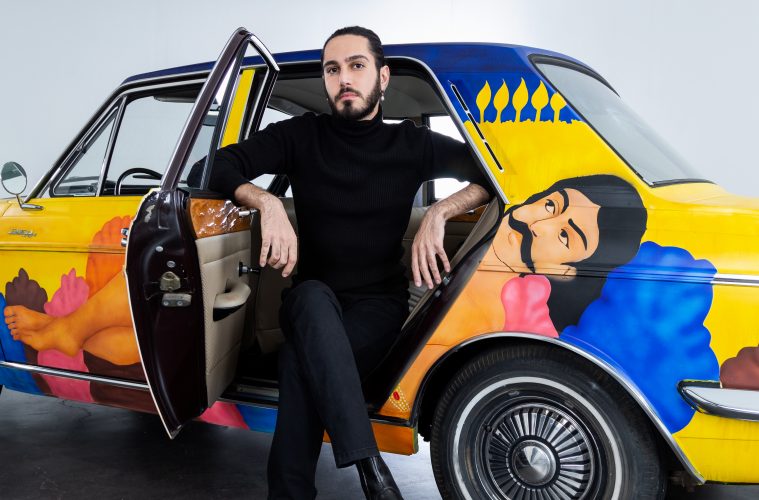Interview by Ayyur
Photos by Tareck Raffoul
This article have been updated on August 3rd, 2022
In the mischief that the universe reveals to those who are willing to listen to its echoes, there is hidden potential to defy norms, to instruct, to denounce and resist the power that tries to suffocate us. These echoes can accompany and nourish us as it does a sacred fire, but can crescendo to subjugate us to its force. Iranian visual activist in exile, Alireza Shojaian, illuminates this dynamic as he addresses to queerness in Iran.
Born in Tehran, Alireza attended Azzad Islamic Art and Architecture University, where silence reigned for him except in the sketches and artworks he showed few teachers. Homosexuality (even suspected) has been considered a capital offense that warrants execution, and, for many, hiding is part of self-protection. His expressiveness opened when a later teacher, Antoine Haddad of the Beirut Art Lab, reminded him to look beyond and create something new. Informed by his own identity and the lives of others, including a friend who was killed for being gay, Alireza produced the well known “Hexagon Series” (2015), followed by series “The Perfect Moment” (2017) and “The Sweet Blasphemy” (2018), which he discussed with the My Kali.
This rising star in committed and queer art continues his momentum with a new work that revolutionizes the medium Alireza works with. Painting on the classic Paykan Hillman Hunter, one given to Romanian dictator Nicolae Ceaușescu by the Shah of Iran, Alireza uses this car as a canvas to exhibit human rights violations in Iran and pay homage to the queers persecuted in the country. In collaboration with PaykanArtCar group, this project has presented challenges and obstacles that highlight the issues of artistic queerness and politics. In May 2022, Alireza, Dr Hiva Feizi (executive director and co founder of the PaykanArtCar) and ambassador Mar Wallace CEO and founder of PaykanArtCar) received the Vaclav Havel award for the Paykan Car project from Mahmoud Farahmand, an Iranian Norwegian parliamentary member in Norway.
This new story, Alireza tells us, without detours.
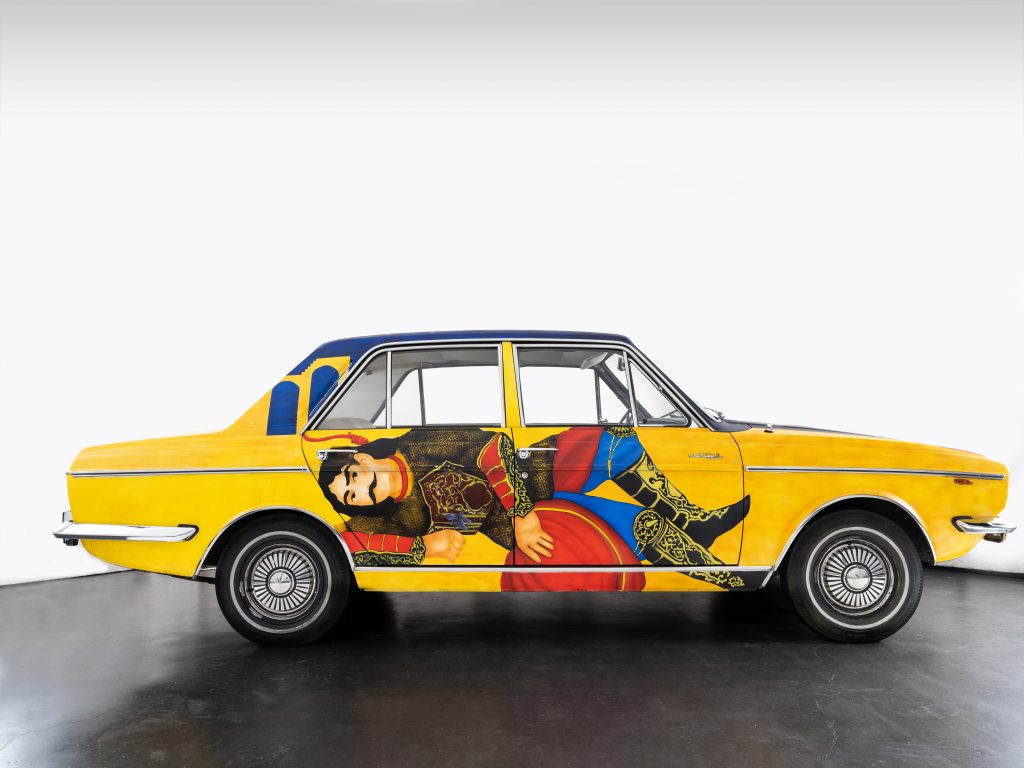
Paykan Car project by Alireza Shojaian – Photo by Tareck Raffoul
From painting to framing to drawing, and now airbrushing on a car. How did this project emerge?
For me, it was a big challenge. As you mentioned, I’ve always used drawing to express what I couldn’t express through words. This is because I had to leave my country and was not in a stable situation, moving from one country to another. Colored pencils were very light and inexpensive, so this was the best material for me as an artist in exile. But moving to a very different area like airbrush… it requires a proper atelier and is a bit expensive because of the materials and equipment. I was not able to do it alone.
When the Paykan project contacted me to ask me to paint on a car, I had no option but to change my materials. I had three days to accept the invitation, three days from the call with Ambassador Mark Valace (Ambassador Mark, the cofounder and ex-ambassador of the United States who is currently in the UN). He told me, “Look, we have a car, that was the car of the Romanian dictator Nicolae Ceaușescu,” and that they were searching for Iranian artists to collaborate with who could paint on the car regarding human rights in Iran.
What is the potential of this car? Everyone was excited to know what would happen to it, and I was sure that it would raise interest when it was shared on social media because it’s a topic that is so taboo in the country. It’s so taboo that no one is really willing to talk about it, and even the media covering the project avoided covering the links to LGBT issues for fear of losing audiences. So, knowing all of this, I really wanted to do this project.
How did this idea come to life after they called you to collaborate?
I did some research to find my general idea, what I wanted to do and reference. They asked how I was going to do this and with what medium, and I said that I thought it would be best to use airbrushing, since I couldn’t work on the car with colored pencils. I’d never even touched an airbrush before, so this was a huge risk. I knew that the project would be covered in the news regardless, and that this was a risk that everyone would see – there was no space to fail.
This is how I moved to airbrushing, but I used color pencil on some parts of the project. This was very a personal decision because I feel sort of connected to colored pencil – if today I’m in France, it’s because of this. I’m in France because my art was seen by the French Embassy in Lebanon, and it was my art that took me to Beirut for those three years. Colored pencils are leading my life and I wanted to stay loyal to them and incorporate them into the project even though it was sort of impossible.
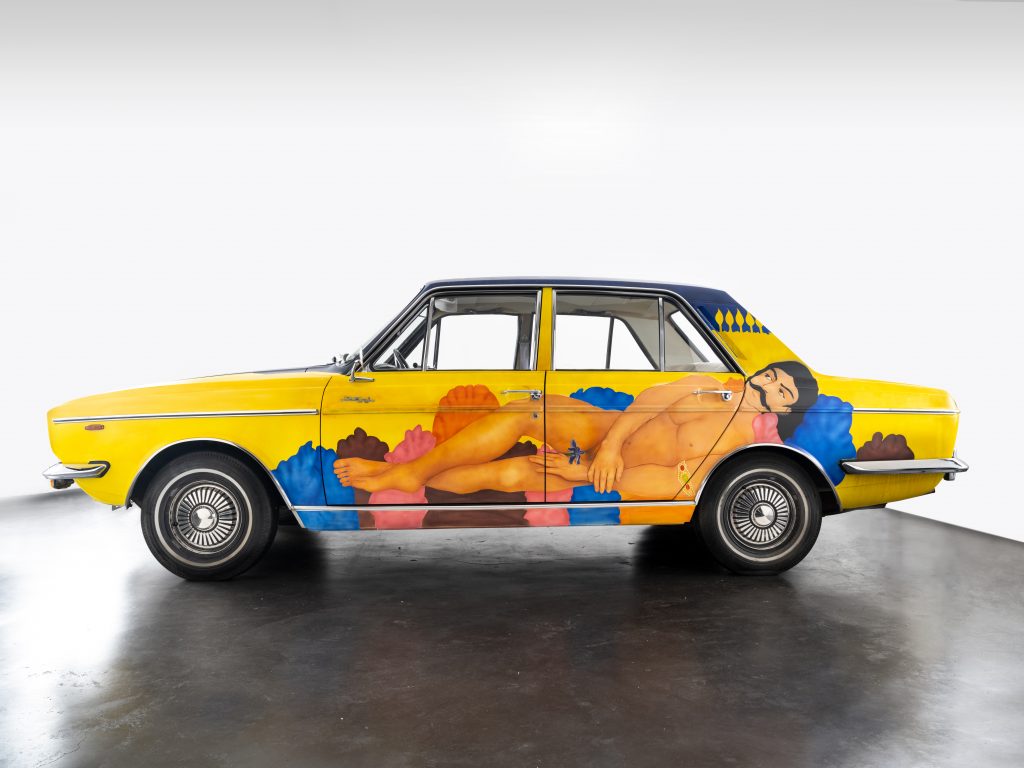
Paykan Car project by Alireza Shojaian – Photo by Tareck Raffoul
The car you work on invokes so much nostalgia, and the story you engrave on it is even older than the car itself. How did you come to choose this story?
I refer to art history whenever I have a large audience because I believe it’s more effective to build on something that is already familiar to people. For example, I referenced Western art for projects I did in Beirut: I referenced the photograph of Robert Mapplethorpe for a work I did for an art fair, and I referenced a French painting now in the Louvre for a piece I did in collaboration with Hamed Sinno.
This time, I wanted to refer to the Iranian artistry through the stories of Sohrab and Shaban (from the Shahnameh, “Book of Kings”). This was so interesting because it was my first opportunity to have the Iranian people as my direct audience, but I never felt related to it when I was in Iran. It’s the story itself and that these paintings would have been done in tea houses, that people would narrate these stories. Sohrab and Shaban is the story of heroes and their fighting. Referencing these as an idea of toxic masculinity was a way to make a paradigm shift; it’s using a story catagory that I wouldn’t fit into as a queer person as the foundation of my project, to provoke and talk about my issues.
This is what made it so shocking. PaykanArtCar was unveiled in the Human Rights Foundation in Miami on October 4th, the same night they did a report on one of the Farsi channels. I was attacked on Twitter and other social media platforms the whole week, and other activists and people were worried about me and asking if I was ok. I looked through all of them and took screen shots because it was a success for me as a queer artist. For the first time, I could create a wave in society and it showed how much homophobia exists in Iranian society. It was also the first time you could see even people with and in oppostion to the regime standing on the same team against queer society. It was the perfect image that everyone should look at: this is what happened in our society and what we need to solve.
The Paykan car itself is also very masculine, and, in Iran, there is an idea that it would be strange if a woman drove it. Using this object that represents masculinity so much was the reason this project touched such a nerve; it’s more than just a car. The fact that it was a gift of a dictator was also inspiring. We hope for a good day to come but don’t have a clear image of it or idea about when it will come. The idea that I, as a queer artist in exile, am painting a car owned by a dictator will not be forgotten; instead of carrying the heavy hand of a dictator, his car is the base for me to narrate my story and carry a message of freedom. The car becomes an image of that good day and how time changes things; they can resist so much but they can’t resist time.
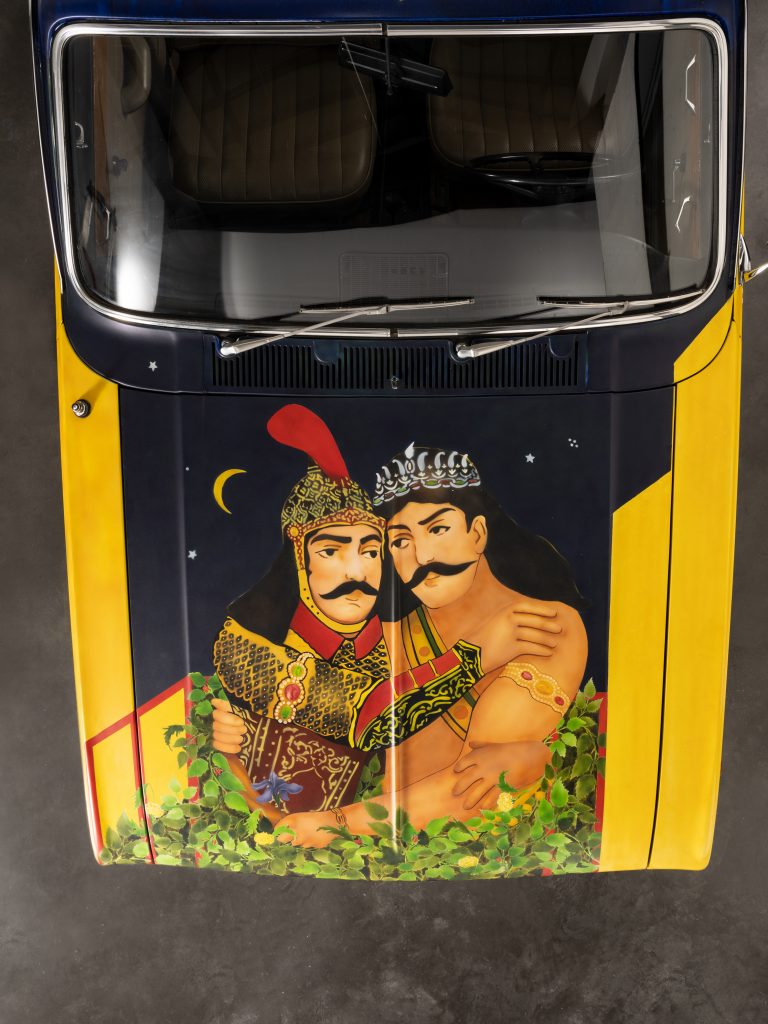
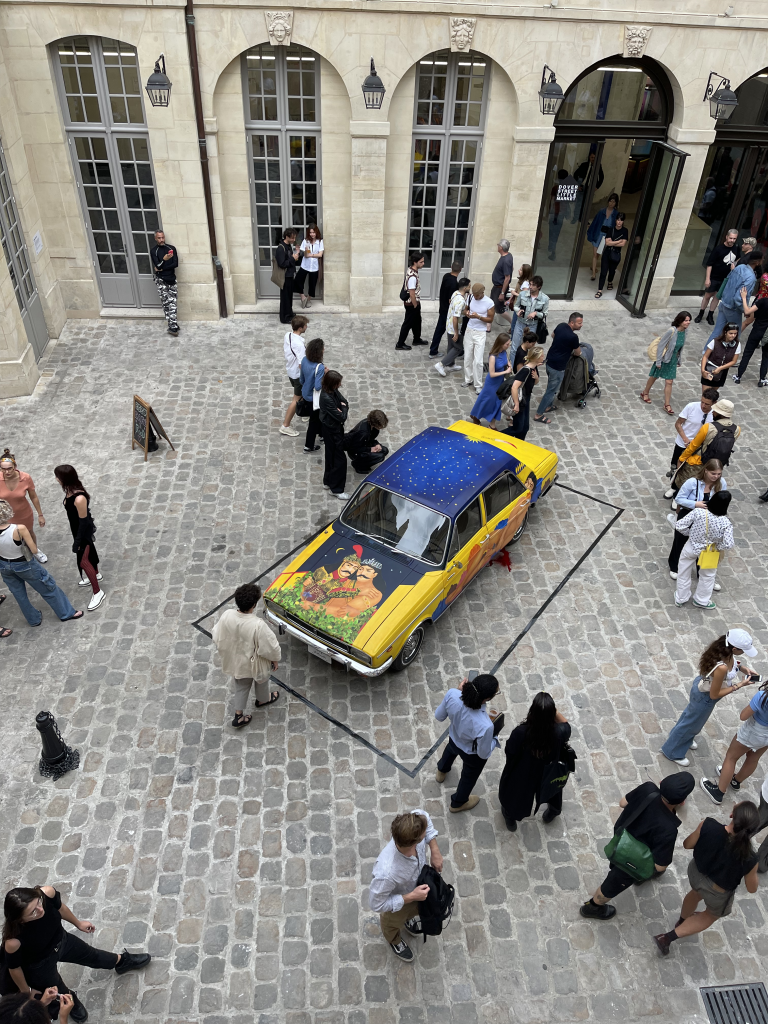
Image on the right; Paykan Car project by Alireza Shojaian exhibited at Exposition Collective Libre N°3” in city Paris – on the left by photo by Tareck Raffoul.
You now define yourself as a visual activist, but you weren’t always exploring your art and queer identity. How have you and your art developed as you have become more public about displaying it?
A lot of French people in the art scene will advise you not to put yourself in a box or fit within a category because it limits your market. But when you have a goal to make a change, it’s important to project yourself as what you are. So many people won’t be successful becasue they don’t have a role model or they don’t think its okay to be queer, or they think they are sinners. But, at the end of the day, when you see someone from your region who is out and speaking openly, and is being accepted and respected, it has the power to be very inspiring.
I feared doing the painting because it took me a long time to accept that I’m not sick and not a sinner or whatever. The idea is to give younger generations an example that we exist. No one wants a “nationwide coming out” – it’s very difficult. I never had a chance to talk directly to my parents directly but I do interviews all over the Iranian media channels and on live TV, so people around the world see I’m queer. It’s difficult and I may be uncomfortable, but I think it’s a topic that is bigger than me; I made the decision that I want to change the situation. I’m in exile and don’t see my family because of who I am and what I wanted to do, but maybe this is a small step toward a day when people don’t have to leave home or fear being killed because of their identity.
This Paykan car narrates the story of love and dying and also makes explicit references to queer stories in Iran. What story were you trying to convey?
More than anything, this car references the story Ali Fazeli Monfared, a 20-year-old gay man who was beheaded for being gay by his brother and his cousins in a very conservative region. He was actually escaping the country; he had a ticket to Turkey for three days after his killing.
The car is not just the painting part but it’s also an installation. The part that we see shows the naked body, and the door is slightly open to represent the head as separated from the body. There is red liquid, blood dripping from the car. There’s a sound component inside of the car, which starts with the voice notes that Ali Fazeli sent to his boyfriend who was in Turkey, saying that he was threatened by his family members.
This is meant to inspire courage to speak out if you find a platform because you might lose the chance. Accepting this project and being excited about it is very important for the whole Iranian queer community, because we’ve never had such opportunity.
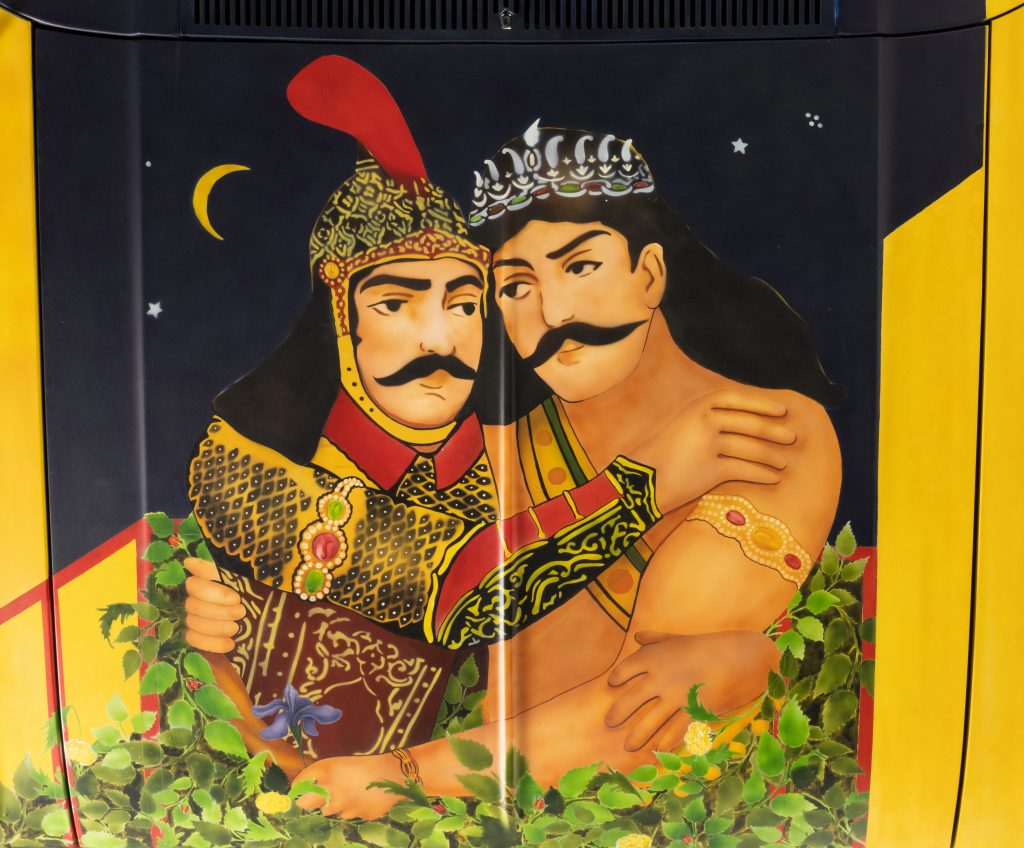
Paykan Car project by Alireza Shojaian – Photo by Tareck Raffoul
The Paykan has become emblematic as an object of repression, facing not only wars within Iraian society but also proxy wars of sorts, wars fought in other places. Can you tell us more about what has recently happened in Paris and the Asia Now Art Fair?
They were very confusing when they censored my work in Paris. They gave us different reasons, one being that this project is extremely political. A few weeks ago, by coincidence, I saw the director of the art fair (who I hadn’t spoken with since this happened) at an exhibition in the Ecole des Beaux Arts. I couldn’t control myself and confronted her. It was an uncomfortable situation because it was a few days after they executed two men in Iran becuase of their homosexuality, though they hid this by saying it was punishment for charges of rape, linking homosexuality to pedophelia to rape. I told her that my project is extremely political – and the way they killed two men for their homosexuality is political and my identity is political and whatever I do will be political. I said she removed my project for this reason.
It’s impossible to talk about the queer society and to draw a body of a queer person and not be political. Some people live in places where they don’t want to see reality and they make decisions based on experience. They don’t care about us because it’s somewhere else. The problem is, when art gets to the level of exhibitions and markets, it’s more about money than responsibility to society. They can pretend to be open-minded and care about human rights as long as the artwork is a luxury item that sells, and as long as it doesn’t cause problems.
For example, one of the most radical artists who works on women’s rights just gave a speech about women in Dubai, but if the same artist wanted to talk about queer women, she would be censored. Those people who didn’t give me space in Iran because they didn’t want to risk their business are still able to censor me because of money, even though time has passed and I’m in Paris.
The fact that the car painted with a story of love and brutality was later censored helps us understand queer issues in Iran and silencing. Can you say more about this?
The project does all of this, but the issue is how we share it with others. We got lots of media coverage outside of France, but no one in France wanted to cover the story even after I contacted them. It’s clear that this is connected to the Iranian regime and their play to remove whoever is outside their party line, no matter who they are. Maybe this won’t happen next time I try to share this story, but it’s scary how easily they can convince people that they are doing something good by censoring it. The director at the fair probably was protecting her team and Iranian galleries from the danger my work would create, not knowing this was just a lie – no one would be questioned for what was happening at an art fair.
NOTE: Alireza’s project ‘Paykan’ can be viewed at the “Exposition Collective Libre n°3” in city Paris – showing until Sunday, August 7th, 2022 at the following address – 3537 rue des Francs-Bourgeois in Paris.

